海啸英文介绍
- 格式:ppt
- 大小:1.29 MB
- 文档页数:7

有关海啸的英文作文初一Title: Tsunamis: Nature's Wrath。
Tsunamis are one of the most powerful and destructive forces of nature. They are often triggered by underwater earthquakes, volcanic eruptions, or landslides, causing massive waves that can devastate coastal areas. In this essay, we will explore the causes, effects, and ways to mitigate the impact of tsunamis.Firstly, let's delve into the causes of tsunamis. As mentioned, the primary trigger is an underwater disturbance, such as an earthquake. When tectonic plates shift suddenly beneath the ocean floor, they displace a large volume of water, generating enormous waves. Similarly, volcanic eruptions can cause the displacement of water, leading to tsunami formation. Additionally, underwater landslides, though less common, can also generate tsunamis by rapidly displacing seawater.The effects of a tsunami can be catastrophic. As the massive waves approach the coast, they gain momentum and height, crashing onto land with tremendous force. Entire communities can be swept away, buildings destroyed, and lives lost within minutes. The aftermath of a tsunami often includes widespread flooding, debris strewn across the landscape, and infrastructure damage. The economic, social, and psychological toll of tsunamis can be immense, leaving survivors to grapple with loss and rebuilding their lives from scratch.However, efforts have been made to mitigate the impact of tsunamis and improve early warning systems. One crucial aspect is education and awareness within vulnerable communities. Teaching residents about the signs of an impending tsunami, evacuation procedures, and designated safe zones can save countless lives. Furthermore, advances in technology have enabled the development of sophisticated warning systems that detect seismic activity and rapidly disseminate alerts to at-risk areas. These early warning systems give people crucial time to evacuate and seek safety before the tsunami strikes.In addition to early warning systems, coastal engineering plays a vital role in mitigating tsunami damage. Building seawalls, barriers, and elevated structures can help buffer the impact of waves and protect coastal communities. Proper urban planning, zoning regulations, and land-use policies can also reduce the risk of developmentin high-risk areas prone to tsunamis.International cooperation is essential in addressingthe threat of tsunamis, as they can affect multiplecountries across vast oceanic regions. Collaborativeefforts in research, data sharing, and disaster responsecan enhance preparedness and resilience against tsunamis.By pooling resources and expertise, nations can better anticipate, mitigate, and respond to the destructive powerof these natural disasters.In conclusion, tsunamis are formidable natural phenomena that pose a significant threat to coastal communities worldwide. Understanding the causes, effects, and mitigation strategies is crucial in safeguarding livesand livelihoods. Through education, early warning systems, coastal engineering, and international cooperation, we can better prepare for and mitigate the impact of tsunamis, reducing their devastation and helping communities recover more swiftly from these catastrophic events.。



海啸的英文小作文The tsunami hit without warning, sweeping away everything in its path. The sheer force of the water was terrifying, and I felt utterly helpless as I watched the destruction unfold.The aftermath was chaotic and devastating. The once bustling streets were now littered with debris and the remains of buildings. It was a scene of utter desolation, and the sense of loss was palpable in the air.The survivors were left to pick up the pieces of their shattered lives. Many had lost their homes, their loved ones, and their sense of security. It was a long and arduous road to recovery, and the scars left by the tsunami would never truly heal.The resilience of the human spirit shone through in the face of such adversity. People came together to support one another, offering whatever help they could. It washeartwarming to see the kindness and compassion that emerged in the wake of such tragedy.The experience was a stark reminder of the awesomepower of nature. It was a humbling and sobering realization that we are mere specks in the grand scheme of the universe, and that we must always be prepared for the unexpected.。
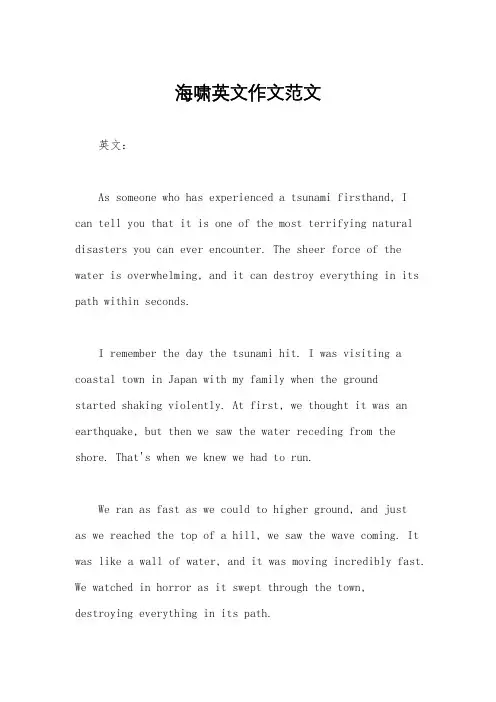
海啸英文作文范文英文:As someone who has experienced a tsunami firsthand, I can tell you that it is one of the most terrifying natural disasters you can ever encounter. The sheer force of the water is overwhelming, and it can destroy everything in its path within seconds.I remember the day the tsunami hit. I was visiting a coastal town in Japan with my family when the groundstarted shaking violently. At first, we thought it was an earthquake, but then we saw the water receding from the shore. That's when we knew we had to run.We ran as fast as we could to higher ground, and justas we reached the top of a hill, we saw the wave coming. It was like a wall of water, and it was moving incredibly fast. We watched in horror as it swept through the town, destroying everything in its path.Thankfully, my family and I were safe, but many others weren't so lucky. The town was completely devastated, and it took years for it to recover.中文:作为一个亲身经历过海啸的人,我可以告诉你,这是你可能遇到的最可怕的自然灾害之一。
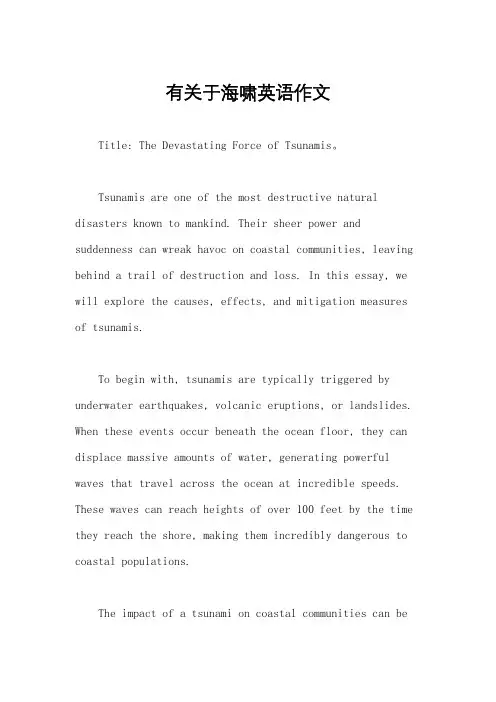
有关于海啸英语作文Title: The Devastating Force of Tsunamis。
Tsunamis are one of the most destructive natural disasters known to mankind. Their sheer power and suddenness can wreak havoc on coastal communities, leaving behind a trail of destruction and loss. In this essay, we will explore the causes, effects, and mitigation measures of tsunamis.To begin with, tsunamis are typically triggered by underwater earthquakes, volcanic eruptions, or landslides. When these events occur beneath the ocean floor, they can displace massive amounts of water, generating powerful waves that travel across the ocean at incredible speeds. These waves can reach heights of over 100 feet by the time they reach the shore, making them incredibly dangerous to coastal populations.The impact of a tsunami on coastal communities can becatastrophic. Entire towns can be swept away in a matter of minutes, leaving behind a scene of devastation and despair. Buildings collapse, infrastructure is destroyed, and lives are lost. The aftermath of a tsunami is often characterized by chaos and despair as communities struggle to recover from the destruction.In addition to the immediate physical damage caused by tsunamis, there are also long-term effects to consider. Coastal ecosystems can be severely damaged, leading to a loss of biodiversity and disruption of fragile ecosystems. The economic impact of tsunamis can also be significant, as coastal communities rely heavily on tourism and fishing industries that may be wiped out by the disaster.Fortunately, there are measures that can be taken to mitigate the impact of tsunamis. Early warning systems can provide coastal communities with valuable time to evacuate to higher ground before a tsunami strikes. These systems rely on a network of sensors and buoys to detect seismic activity and monitor sea levels in real-time. In addition to early warning systems, coastal infrastructure can bedesigned to withstand the force of a tsunami, including the construction of seawalls and elevated buildings.Education and preparedness are also key components of tsunami mitigation. By educating the public about the risks associated with tsunamis and providing training in evacuation procedures, communities can better prepare themselves for the possibility of a disaster. This includes regular drills and exercises to ensure that everyone knows what to do in the event of a tsunami.In conclusion, tsunamis are a powerful and destructive force of nature that can have devastating consequences for coastal communities. By understanding the causes andeffects of tsunamis and implementing effective mitigation measures, we can work towards reducing the impact of these disasters and protecting the lives and livelihoods of those who call the coast home.。
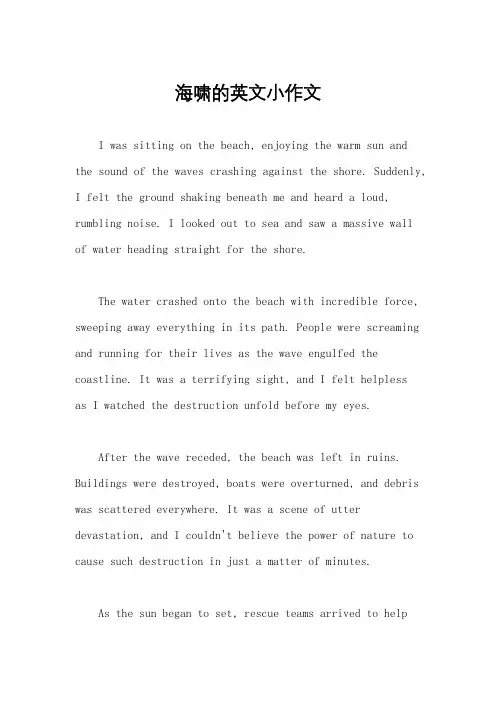
海啸的英文小作文I was sitting on the beach, enjoying the warm sun and the sound of the waves crashing against the shore. Suddenly, I felt the ground shaking beneath me and heard a loud, rumbling noise. I looked out to sea and saw a massive wallof water heading straight for the shore.The water crashed onto the beach with incredible force, sweeping away everything in its path. People were screaming and running for their lives as the wave engulfed the coastline. It was a terrifying sight, and I felt helplessas I watched the destruction unfold before my eyes.After the wave receded, the beach was left in ruins. Buildings were destroyed, boats were overturned, and debris was scattered everywhere. It was a scene of utter devastation, and I couldn't believe the power of nature to cause such destruction in just a matter of minutes.As the sun began to set, rescue teams arrived to helpthose who had been injured or stranded by the tsunami. It was a chaotic and emotional scene as people searched for their loved ones and tried to make sense of the disaster that had struck their community.In the days that followed, the community came together to clean up and rebuild. It was heartwarming to see everyone working together to overcome the tragedy and restore their lives. The resilience and strength of the human spirit was truly inspiring in the face of such a devastating event.Looking back on that day, I am reminded of thefragility of life and the unpredictability of nature. The experience has taught me to cherish every moment and to always be prepared for the unexpected. The tsunami may have left a mark on the community, but it also brought out the best in people and showed the power of unity in the face of adversity.。
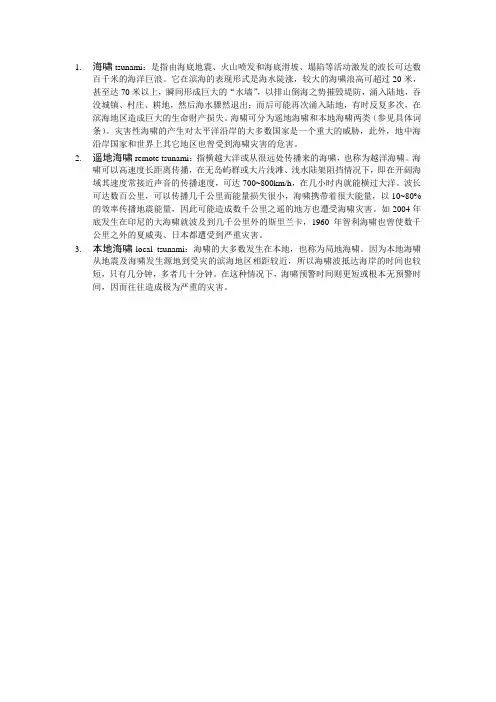
1.海啸tsunami:是指由海底地震、火山喷发和海底滑坡、塌陷等活动激发的波长可达数
百千米的海洋巨浪。
它在滨海的表现形式是海水陡涨,较大的海啸浪高可超过20米,甚至达70米以上,瞬间形成巨大的“水墙”,以排山倒海之势摧毁堤防,涌入陆地,吞没城镇、村庄、耕地,然后海水骤然退出;而后可能再次涌入陆地,有时反复多次,在滨海地区造成巨大的生命财产损失。
海啸可分为遥地海啸和本地海啸两类(参见具体词条)。
灾害性海啸的产生对太平洋沿岸的大多数国家是一个重大的威胁,此外,地中海沿岸国家和世界上其它地区也曾受到海啸灾害的危害。
2.遥地海啸remote tsunami:指横越大洋或从很远处传播来的海啸,也称为越洋海啸。
海
啸可以高速度长距离传播,在无岛屿群或大片浅滩、浅水陆架阻挡情况下,即在开阔海域其速度常接近声音的传播速度,可达700~800km/h,在几小时内就能横过大洋。
波长可达数百公里,可以传播几千公里而能量损失很小,海啸携带着很大能量,以10~80%的效率传播地震能量,因此可能造成数千公里之遥的地方也遭受海啸灾害。
如2004年底发生在印尼的大海啸就波及到几千公里外的斯里兰卡,1960年智利海啸也曾使数千公里之外的夏威夷、日本都遭受到严重灾害。
3.本地海啸local tsunami:海啸的大多数发生在本地,也称为局地海啸。
因为本地海啸
从地震及海啸发生源地到受灾的滨海地区相距较近,所以海啸波抵达海岸的时间也较短,只有几分钟,多者几十分钟。
在这种情况下,海啸预警时间则更短或根本无预警时间,因而往往造成极为严重的灾害。
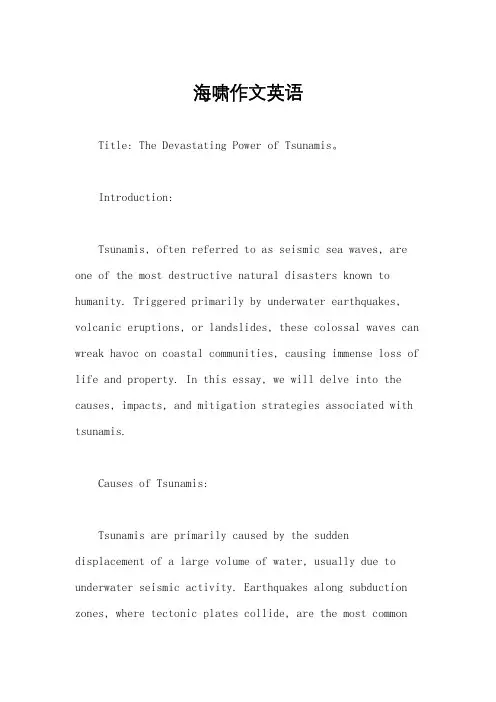
海啸作文英语Title: The Devastating Power of Tsunamis。
Introduction:Tsunamis, often referred to as seismic sea waves, are one of the most destructive natural disasters known to humanity. Triggered primarily by underwater earthquakes, volcanic eruptions, or landslides, these colossal waves can wreak havoc on coastal communities, causing immense loss of life and property. In this essay, we will delve into the causes, impacts, and mitigation strategies associated with tsunamis.Causes of Tsunamis:Tsunamis are primarily caused by the sudden displacement of a large volume of water, usually due to underwater seismic activity. Earthquakes along subduction zones, where tectonic plates collide, are the most commontriggers. When these plates shift, they can uplift or submerge large areas of the ocean floor, displacing massive amounts of water and generating powerful waves. Additionally, volcanic eruptions and underwater landslides can also displace water, albeit less frequently than earthquakes.Impacts of Tsunamis:The impact of tsunamis on coastal communities can be catastrophic. Upon reaching the shore, these waves can surge inland with incredible force, destroying everythingin their path. Infrastructure such as buildings, roads, and bridges are often swept away, leaving behind a trail of devastation. Moreover, the loss of human life can be staggering, as tsunamis strike with little to no warning, leaving residents with little time to evacuate.Furthermore, tsunamis can have long-lasting environmental consequences. The influx of saltwater into coastal ecosystems can disrupt delicate habitats, endangering marine life and compromising coastalbiodiversity. Additionally, the destruction of coral reefs and mangrove forests, which serve as natural barriers against coastal erosion, can exacerbate the impact offuture tsunamis.Mitigation Strategies:While tsunamis cannot be prevented, their impact can be mitigated through effective preparedness and early warning systems. Governments and disaster management agencies play a crucial role in implementing and maintaining these systems, which rely on seismic monitoring networks and ocean sensors to detect underwater disturbances.Education and public awareness are also essential components of tsunami preparedness. By educating coastal residents about the signs of an impending tsunami and providing them with evacuation routes and procedures, communities can better respond to these disasters and minimize loss of life.Furthermore, the construction of tsunami-resistantinfrastructure, such as seawalls and elevated buildings,can help mitigate the damage caused by these waves. These structures are designed to withstand the force of a tsunami and provide a safe haven for residents during an evacuation.Conclusion:In conclusion, tsunamis are natural disasters of immense power and destructive potential. While their occurrence cannot be prevented, the impact of tsunamis can be mitigated through effective preparedness, early warning systems, and resilient infrastructure. By prioritizingsafety and resilience, coastal communities can better withstand the onslaught of these colossal waves andminimize the loss of life and property.。
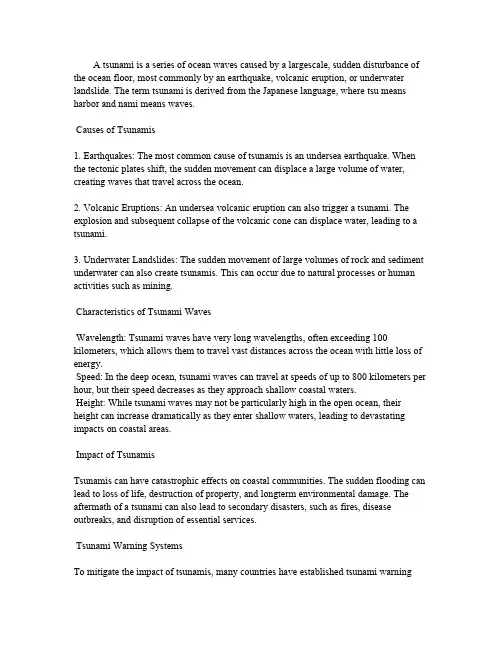
A tsunami is a series of ocean waves caused by a largescale,sudden disturbance of the ocean floor,most commonly by an earthquake,volcanic eruption,or underwater landslide.The term tsunami is derived from the Japanese language,where tsu means harbor and nami means waves.Causes of Tsunamis1.Earthquakes:The most common cause of tsunamis is an undersea earthquake.When the tectonic plates shift,the sudden movement can displace a large volume of water, creating waves that travel across the ocean.2.Volcanic Eruptions:An undersea volcanic eruption can also trigger a tsunami.The explosion and subsequent collapse of the volcanic cone can displace water,leading to a tsunami.3.Underwater Landslides:The sudden movement of large volumes of rock and sediment underwater can also create tsunamis.This can occur due to natural processes or human activities such as mining.Characteristics of Tsunami WavesWavelength:Tsunami waves have very long wavelengths,often exceeding100 kilometers,which allows them to travel vast distances across the ocean with little loss of energy.Speed:In the deep ocean,tsunami waves can travel at speeds of up to800kilometers per hour,but their speed decreases as they approach shallow coastal waters.Height:While tsunami waves may not be particularly high in the open ocean,their height can increase dramatically as they enter shallow waters,leading to devastating impacts on coastal areas.Impact of TsunamisTsunamis can have catastrophic effects on coastal communities.The sudden flooding can lead to loss of life,destruction of property,and longterm environmental damage.The aftermath of a tsunami can also lead to secondary disasters,such as fires,disease outbreaks,and disruption of essential services.Tsunami Warning SystemsTo mitigate the impact of tsunamis,many countries have established tsunami warningsystems.These systems use a network of sensors and buoys to detect changes in sea level that could indicate an approaching tsunami.Once a tsunami is detected,warnings are issued to coastal communities,allowing for evacuation and other protective measures.Historical Tsunami EventsSome of the most devastating tsunamis in history include:2004Indian Ocean Tsunami:Triggered by an undersea earthquake off the coast of Sumatra,Indonesia,this tsunami affected14countries and resulted in the deaths of over 230,000people.2011Tōhoku Tsunami:Caused by a magnitude9.0earthquake off the coast of Japan, this tsunami led to the Fukushima nuclear disaster and claimed over15,000lives. ConclusionTsunamis are a powerful and destructive force of nature.Understanding their causes, characteristics,and impacts is crucial for developing effective strategies to protect coastal communities from these natural disasters.As our knowledge of tsunamis and our ability to predict and respond to them improves,we can hope to minimize the loss of life and property in the face of these events.。
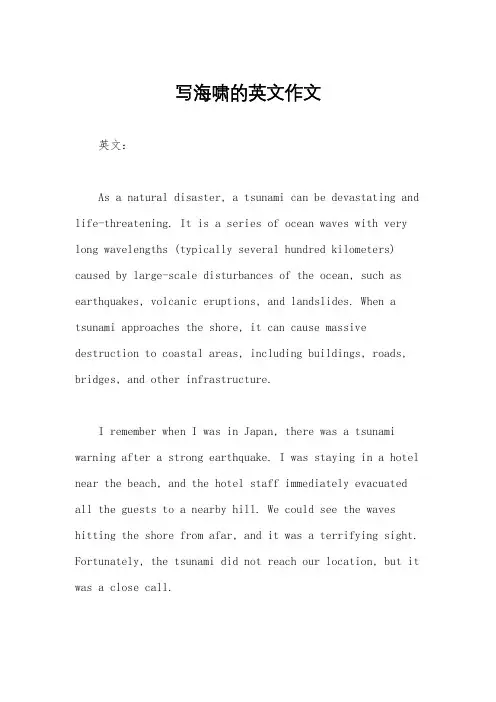
写海啸的英文作文英文:As a natural disaster, a tsunami can be devastating and life-threatening. It is a series of ocean waves with very long wavelengths (typically several hundred kilometers) caused by large-scale disturbances of the ocean, such as earthquakes, volcanic eruptions, and landslides. When a tsunami approaches the shore, it can cause massive destruction to coastal areas, including buildings, roads, bridges, and other infrastructure.I remember when I was in Japan, there was a tsunami warning after a strong earthquake. I was staying in a hotel near the beach, and the hotel staff immediately evacuated all the guests to a nearby hill. We could see the waves hitting the shore from afar, and it was a terrifying sight. Fortunately, the tsunami did not reach our location, but it was a close call.Tsunamis can also have a devastating impact on marine life. The waves can cause massive fish kills, as well as damage to coral reefs and other marine ecosystems. In addition, tsunamis can have long-term effects on the environment, such as changes in water temperature and salinity.中文:海啸是一种自然灾害,它可以毁灭性地威胁人类的生命。
Tsunamis are one of the most powerful and destructive natural phenomena that can occur in the ocean.They are often triggered by undersea earthquakes,volcanic eruptions, or landslides,and can travel vast distances across the ocean,causing widespread damage to coastal areas.Causes of TsunamisTsunamis are typically caused by the sudden displacement of a large volume of water. The most common cause is an undersea earthquake,which can displace the water above the epicenter of the quake.The sudden rise and fall of the sea floor can create a series of waves that radiate outward from the disturbance.These waves can travel at speeds of up to500miles per hour800kilometers per hour and can reach heights of over100feet30 meters when they approach the shore.Characteristics of Tsunami WavesUnlike typical ocean waves,tsunami waves are very long and have a much longer wavelength.This means that they can travel much faster and carry a lot more energy than regular waves.The height of a tsunami wave can vary greatly,with some waves being only a few feet high,while others can be tens of meters tall.The speed of a tsunami wave also depends on the depth of the water it is traveling through,with waves moving faster in deeper water and slowing down as they approach the shore.Effects of TsunamisThe effects of a tsunami can be devastating.As the waves approach the shore,they can inundate coastal areas,causing flooding and damage to buildings and infrastructure.The force of the waves can also cause erosion and the displacement of large amounts of sediment,which can alter the shape of the coastline.In addition to the physical damage, tsunamis can also have a significant impact on the economy and the environment.The destruction of homes,businesses,and infrastructure can lead to longterm economic hardship for affected communities,and the disruption of ecosystems can have lasting effects on marine life and coastal habitats.Warning and PreparednessGiven the potential for widespread destruction,it is crucial to have effective warning systems in place to alert communities to the threat of a tsunami.Many countries have established tsunami warning systems that use a network of sensors and buoys to detect the initial waves and provide early warning to coastal areas.In addition to thesetechnological solutions,it is also important for individuals and communities to be prepared for the possibility of a tsunami.This can include having an emergency plan in place,knowing the location of evacuation routes,and having supplies on hand in case of an evacuation.Recovery and ReconstructionThe recovery and reconstruction process following a tsunami can be a long and difficult one.It often involves not only rebuilding physical infrastructure but also addressing the social and economic impacts of the disaster.This can include providing support for displaced individuals,restoring damaged ecosystems,and helping businesses to recover. The process can also provide an opportunity to improve resilience to future disasters, through the implementation of better building codes,improved landuse planning,and the development of more effective warning systems.In conclusion,tsunamis are a powerful and potentially devastating force of nature. Understanding their causes,characteristics,and effects can help us to better prepare for and respond to these events,reducing their impact on our communities and our environment.。
有关海啸的英文作文初一英文:As a middle school student, I have learned a lot about tsunamis in my geography class. Tsunamis are a series of ocean waves with very long wavelengths (typically hundreds of kilometers) caused by large-scale disturbances of the ocean, such as earthquakes, volcanic eruptions, and underwater landslides.Tsunamis can cause tremendous destruction when they hit coastal areas. I remember learning about the 2004 Indian Ocean tsunami, which was triggered by a massive earthquake off the coast of Sumatra, Indonesia. The tsunami waves traveled across the Indian Ocean and caused widespread devastation in countries like Indonesia, Sri Lanka, India, and Thailand. It was a tragic event that resulted in the loss of over 230,000 lives.In addition to the Indian Ocean tsunami, there havebeen other devastating tsunamis in history, such as the 2011 tsunami in Japan, which was caused by a powerful undersea earthquake. The tsunami waves reached heights of over 40 meters in some areas, causing widespread destruction and the meltdown of the Fukushima Daiichi nuclear power plant.Tsunamis are particularly dangerous because they can travel across entire ocean basins, carrying their destructive energy with them. This means that even people in distant coastal areas can be affected by a tsunami that was generated thousands of kilometers away.中文:作为一个初中生,我在地理课上学到了很多关于海啸的知识。
英文作文介绍海啸英文:Tsunami is a natural disaster that occurs when a large body of water, such as an ocean or sea, experiences a sudden displacement of water. This can be caused by a variety of factors, including earthquakes, volcanic eruptions, landslides, and even meteorite impacts.When a tsunami occurs, it can cause massive destruction to coastal communities, including flooding, damage to buildings and infrastructure, and loss of life. In some cases, entire towns and cities can be wiped out by the force of the waves.One of the most devastating tsunamis in recent history occurred in 2004, when a massive earthquake off the coast of Indonesia triggered a tsunami that killed over 200,000 people in 14 countries. This event serves as a stark reminder of the power and destructive force of thesenatural disasters.中文:海啸是一种自然灾害,当一个大的水体,如海洋或海湾,经历了突然的水位变化时,就会发生海啸。
海嘯海嘯的英文Tsunami,來自日語「津波」,意指港口內的波浪。
因海底地震,海底火山爆發或海底山崩而引發的巨型海浪,常造成海岸地區巨大災害。
在大洋中,海嘯的波長可長達數百公里,但波高不及1公尺,因此在傳送過程不易被發現。
情況由水下地震﹑火山爆發或水下塌陷和滑坡所激起的巨浪。
破壞性的地震海嘯﹐只在地震構造運動出現垂直斷層﹐震源深度小於20~50公里﹐而里氏震級大於 6.5的條件下才能發生。
統計常用的地震海嘯震級()是以里氏地震震級(M )為主要依據的。
日本學者飯田汲事曾提出海嘯的震級與海嘯的能量和最大湧潮的高程的統計關係。
海嘯的能量大致為10~10爾格﹐一般為海嘯地震的能量的1~10%。
波長1海嘯是一種頻率介於潮波和湧浪之間的重力長波﹐其波長約為幾十至幾百公里﹐週期為2~200分﹐最常見的是2~40分。
傳播速度由確定(c 為傳播速度﹐g 為重力加速度﹐為海區深度)。
若取大洋平均深度為4公里﹐週期為40分鐘﹐則相應的海嘯波的傳播速度為713公里/小時﹐波長為475公里。
波長2海嘯從發生地區由內而外傳播,一般在深而遼闊的海洋,傳播速度約一小時500至1000公里,浪高不超過一公尺。
海嘯的波長可達一百里,週期約為10至20分鐘,在大海中波高只有一公尺,但靠近海岸,波高可達十公尺,因此相對的波峰接近海岸時,海水面會下降,形成海水退後的現象。
海嘯屬可傳播很遠的長波,其傳播速率隨著深度而變,例如:太平洋平均深度約4,000公尺,其傳播速度約2000m/sec,而能以約一天的時間,由太平洋之一岸傳播至另一岸。
研究狀況 1海嘯的研究﹐包括理論研究和模擬實驗兩方面。
19世紀初﹐法國數學家A.L.柯西和S.D.泊松提出求解小振幅波的初值問題﹐為海嘯的理論研究奠定了基礎。
1883年喀拉喀托火山爆發引起的大海嘯﹐促使人們更重視海嘯的研究。
理論研究的內容包括﹕1.海嘯產生的機制﹐2.海嘯在大洋中的自由傳播﹐3.海嘯在近岸帶中的傳播﹐4.海灣內和大陸架上的海嘯動力學研究。
关于海啸的英语作文2篇关于海啸的英语作文文章一:What is a Tsunami?A tsunami, also known as a seismic sea wave, is a natural disaster that can cause enormous destruction and loss of life. It occurs when there is a sudden disturbance under the ocean, such as an earthquake, volcanic eruption, or underwater landslide. This disturbance generates powerful waves that travel across the ocean until they reach the coastline.Tsunamis can travel at high speeds and can reach heights of 30 meters or more when they hit the shore. Unlike regular ocean waves, which are caused by the wind, tsunamis are created by the displacement of a large volume of water. This displacement creates a chain reaction, causing the initial disturbance to grow in size as it moves across the ocean.文章二:Preventing and Preparing for TsunamisWhile we cannot prevent tsunamis from occurring, we can take measures to reduce their impact and save lives. Here are some important steps that can be taken to prevent and prepare for tsunamis:2. Public Education: Educating the public about tsunamis can help raise awareness and ensure that people know what to do in case of an emergency. This includes teaching people how to recognize the signs of a tsunami, understanding evacuation routes, and knowing where to seek shelter.3. Building Codes and Infrastructure: Implementing strict building codes and regulations can help ensure that infrastructure and buildings are designed to withstand the impact of tsunamis. Constructing tsunami-resistant structures and creating safe zones can greatly reduce the loss of life and damage caused by these natural disasters.5. International Cooperation: Tsunamis do not recognize borders, so international cooperation is vital for effective prevention and response.Countries should work together to share information, resources, and expertise in order to minimize the impact of tsunamis on a global scale.In conclusion, tsunamis are powerful and destructive natural disasters, but with proper prevention and preparation, their impact can be minimized. By implementing early warning systems, educating the public, strengthening infrastructure, and promoting international cooperation, we can work towards a safer and more resilient world in the face of tsunamis.。